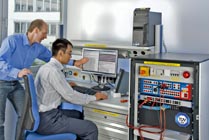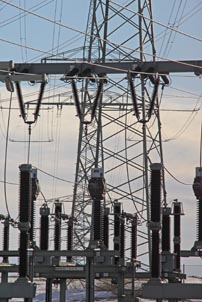Smart grids apply advanced automated control technologies to the power grid. By ensuring that the various power grid components interact appropriately, smart grids enhance power quality, grid reliability and overall safety. Thus, it is in every stakeholder's best interest to foster smart-grid technologies. One obstacle, however, to smart-grid advancement, are diverse, incompatible standards. Diversity, however, is the lifeblood of innovation and advancement. This article shows how diversity, when combined with IEC 61850 interoperability is synergistic.
Some national and international infrastructures, such as the Internet and telecommunications networks, have already demonstrated that infrastructure development can be effectively managed with the help of standards. There is no reason to believe the worldwide development of intelligent power networks or “smart grids” will be an exception.
For virtually any power grid topology, smart grids improve the grid's efficiency, reliability, safety and power quality. Smart grids are also particularly capable of managing complexity. This capability is especially important in view of the growing number of small, distributed energy resources (DER), such as residential photovoltaic systems and combined heat and power systems (CHP). In the future, there will not be a clean division between energy producers and consumers. Theoretically, any consumer with DER can become a power producer. DER promises to make power grids more robust[1], but also more complex and hence, more difficult to manage.
DER increases management complexity because DER are often renewable energy resources. Renewable energy resources generate power when the resource (such as solar or wind) is available. This takes power generation out of the operator's control, but the DER intermittency's effects must still be managed. Optimal solutions require energy storage to buffer supply and demand imbalances. Local energy storage is a powerful tool for managing local power quality issues caused by DER intermittency. Here too, industry and private households can have a valuable contribution.
By applying advanced information and communication technologies, smart grids promise to align fluctuating electricity supply, demand, and storage throughout the day. Maintaining acceptable power quality and continuity will require well co-ordinated balancing of generation and consumer and storage activity.
Data transfer for control processes
As DER becomes increasingly common, smart grids need unprecedented visibility into and control of consumer, generator, and storage states and reserve capacities. In addition, distribution-level power quality must be monitored and managed. For optimum results, the embedded measurement and control devices must be able to transmit and process large quantities of data. Looking at the large number of vendors manufacturing smart-grid components, we quickly realise that interoperability can be an issue. Standardization is a “tried and true” solution that can facilitate efficient and reliable data transfer throughout the grid at all levels. If operators are to have device interoperability, interfaces, communication protocols, and operational procedures will have to be standardized.

Figure 1: For testing smart-grid components related to the IEC 61850, laboratories need an accreditation by the UCA. This is part of the accredited testing laboratory for smart energy technology at TÜV SÜD.
Communication standards
Standards creation is not an easy process. Often there are numerous stakeholders, all of whom who have specific agendas. In the smart-grid arena, some dominant stakeholders are governments, grid operators and vendors. Organizations such as the Institute of Electrical and Electronics Engineers (IEEE) and International Electrotechnical Commission (IEC) take input from the various stakeholders, consider the latest scientific findings, and draw up standards that build on areas of stakeholder agreement and reconcile stakeholder differences.
At present, IEC 61850 is commonly considered the communications and interoperability standard of choice. Originally devised for substation automation system data transfer, it has been recognized as viable for power generator, consumer, and distribution system data transfer as well. IEC 61850's modular architecture and its use of XML files for configuration permit comprehensive data transfer between virtually any two IEC 61850 compliant devices within a power grid. The standard's inherent flexibility makes it a useful lingua franca, since it can interface with other standards such as IEC 60870-5-101 or 60870-5-104. These telecontrol protocols are slated for gradual replacement by IEC 61850.
While Europe, large parts of Asia, and the Middle East are increasingly implementing IEC 61850, this standard has not gained equal acceptance throughout the world. One notable holdout is the United States, where its application is still the subject of discussion.
Standardization in the United States
The U.S. has numerous excellent standardization boards. As these boards have perceived needs, they have published “standards.” The USA had over 75 different smart-grid standards in 2010 that are applicable. Most of these standards had no relation to IEC 61850. Protocols common in the United States include DNP3, IEC 60870-5-101, and IEC 60870-5-104; less common standards include BACnet, LON, WEQ19, REQ18, Multispeak, and OpenADR. Many are compatible with IEC 61850, but some, such as SEP, are not.
When attempting to consolidate these standards, experts frequently come up against obstacles. In response, the Smart Grid Interoperability Panel (SGIP) appointed a coordination team to orchestrate harmonizing the various standards. It developed 15 priority action plans (PAP), the goals of which are to ensure interoperability. From this, we can safely conclude that generally, the incompatibilities are more apparent than real; they can be resolved.
Smart meter and e-car communication protocols are a case in point; the devices frequently comply with local IEEE standards, yet those standards can still be integrated into the IEC 61850 world. When new standards maintain interoperability, they may be an effective path for innovation. In the long run, standards interoperability may actually facilitate smart-grid advancement.

Future-oriented approaches
Establishing smart grids throughout the world poses challenges for which standards are effective solutions. In this context, both a lack of standards (i.e. proprietary protocols) and incompatible and/or competing standards all hinder smart-grid development.
Some IEC 61850 incompatible standards are nationally mandated. This could be a weak strategy, however. National, standalone solutions may lead to competitive disadvantages that should not be underestimated. For example, replacement components may be less readily available and more expensive. The various European and U.S. standards have influenced and benefited from each other. In fact, IEC 61850 incorporates many innovations introduced in U.S. standards. Perhaps the reason that IEC 61850 has gained so much acceptance globally is that it has drawn on and incorporated the “best of the best” innovations.
In order to foster smart-grid advancement, only standards that can demonstrate interoperability with IEC 61850 should be used. Furthermore, to ensure interoperability, new standards should at least follow the structure and concept of the IEC 61850 standard. Deviations should only be accepted if they are necessary and well justified.
Smart grids are a cost-effective means of ensuring a reliable and efficient power grid. However, the proliferation of proprietary, non-interoperable, systems is hampering development and market acceptance. Standards interoperability effectively facilitates innovation and promotes international smart-grid development. Thus, aligning new standards with IEC 61850 and designing innovative ideas so that they are IEC 61850 compatible are winning strategies. Advances that cannot be integrated with IEC 61850 will hamper smart-grid development and should be avoided wherever possible.
Advertisement
Learn more about TUV SUD America





